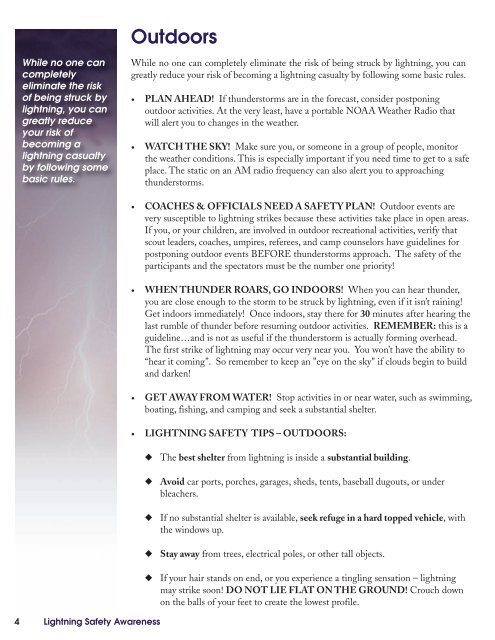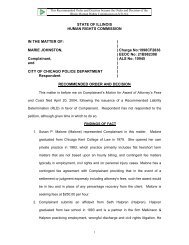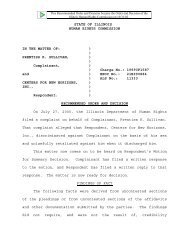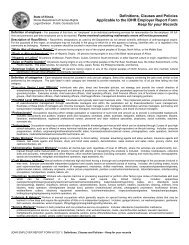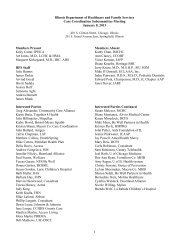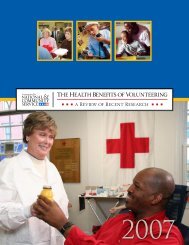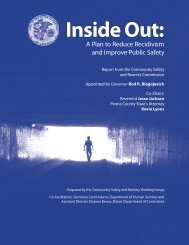lightning safety awareness booklet (PDF, 1.97 MB) - State of Illinois
lightning safety awareness booklet (PDF, 1.97 MB) - State of Illinois
lightning safety awareness booklet (PDF, 1.97 MB) - State of Illinois
You also want an ePaper? Increase the reach of your titles
YUMPU automatically turns print PDFs into web optimized ePapers that Google loves.
OutdoorsWhile no one cancompletelyeliminate the risk<strong>of</strong> being struck by<strong>lightning</strong>, you cangreatly reduceyour risk <strong>of</strong>becoming a<strong>lightning</strong> casualtyby following somebasic rules.While no one can completely eliminate the risk <strong>of</strong> being struck by <strong>lightning</strong>, you cangreatly reduce your risk <strong>of</strong> becoming a <strong>lightning</strong> casualty by following some basic rules.• PLAN AHEAD! If thunderstorms are in the forecast, consider postponingoutdoor activities. At the very least, have a portable NOAA Weather Radio thatwill alert you to changes in the weather.• WATCH THE SKY! Make sure you, or someone in a group <strong>of</strong> people, monitorthe weather conditions. This is especially important if you need time to get to a safeplace. The static on an AM radio frequency can also alert you to approachingthunderstorms.• COACHES & OFFICIALS NEED A SAFETY PLAN! Outdoor events arevery susceptible to <strong>lightning</strong> strikes because these activities take place in open areas.If you, or your children, are involved in outdoor recreational activities, verify thatscout leaders, coaches, umpires, referees, and camp counselors have guidelines forpostponing outdoor events BEFORE thunderstorms approach. The <strong>safety</strong> <strong>of</strong> theparticipants and the spectators must be the number one priority!• WHEN THUNDER ROARS, GO INDOORS! When you can hear thunder,you are close enough to the storm to be struck by <strong>lightning</strong>, even if it isn’t raining!Get indoors immediately! Once indoors, stay there for 30 minutes after hearing thelast rumble <strong>of</strong> thunder before resuming outdoor activities. REME<strong>MB</strong>ER: this is aguideline…and is not as useful if the thunderstorm is actually forming overhead.The first strike <strong>of</strong> <strong>lightning</strong> may occur very near you. You won’t have the ability to“hear it coming”. So remember to keep an "eye on the sky" if clouds begin to buildand darken!• GET AWAY FROM WATER! Stop activities in or near water, such as swimming,boating, fishing, and camping and seek a substantial shelter.• LIGHTNING SAFETY TIPS – OUTDOORS:◆◆◆◆◆The best shelter from <strong>lightning</strong> is inside a substantial building.Avoid car ports, porches, garages, sheds, tents, baseball dugouts, or underbleachers.If no substantial shelter is available, seek refuge in a hard topped vehicle, withthe windows up.Stay away from trees, electrical poles, or other tall objects.If your hair stands on end, or you experience a tingling sensation – <strong>lightning</strong>may strike soon! DO NOT LIE FLAT ON THE GROUND! Crouch downon the balls <strong>of</strong> your feet to create the lowest pr<strong>of</strong>ile.4 Lightning Safety Awareness


